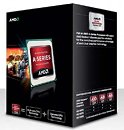Monday, June 30th 2014

AMD Unveils A10-7800 Quad-core Socket FM2+ APU
AMD unveiled a new mid-range APU to take on Intel's Core i3 "Haswell" processors, the A10-7800 (model: AD7800YBI44JA). Based on the 28 nm "Kaveri" silicon, and built in the socket FM2+ package, this part differs from the A10-7850K in lacking an unlocked CPU base clock multiplier, and a rated TDP of just 65W (compared to the former's 95W). The A10-7800 features four x86-64 cores based on the "Steamroller" micro-architecture, spread across two modules, featuring 4 MB (2x 2 MB) of L2 cache; clocked at 3.50 GHz, with a TurboCore frequency of 3.90 GHz. Also featured is Radeon R7 Series integrated GPU featuring 512 GCN2 cores, with support for AMD Mantle and DirectX 11.2. Its uncore component features a dual-channel DDR3 integrated memory controller, with support for DDR3-1866 MHz, and a PCI-Express gen 3.0 root complex. It's expected to be priced between US $140 and $150.

30 Comments on AMD Unveils A10-7800 Quad-core Socket FM2+ APU
AMD are probably just trying to milk the max cash out of the Kaveri. If the A8-7600 ever launches, consumers will have grown tired of waiting, because after a delay of almost a year, and will have already bought some other chip. Perhaps they launch it as the good value swan song after they have announced the next gen APU.
such conspiracy
many wows
No?
Not interested then.
What part makes the 7600 a better choice?
When Kaveri come out 7600 was a dream come true for the AMD platform. If you wanted to build an all around office PC, or an internet PC, or a light gaming PC, or an HTPC, or a PC to do a little of all the above, 7600 was just perfect. Configurable TDP as low as 45W, quad core over 3GHz, 384 stream processors, HSA, GCN, Mantle, TrueAudio. Compared to the $152 for the 7700K and the $173 of the 7850K, 7600 at $119 was the only Kaveri APU that there was logic in buying it.
Unfortunately AMD used the 7600 only for positive feedback on the Kaveri and hoped that most people who will lose their patience will just wait doing nothing or go for the higher models that have better margins.
In my case that I sold one of my AM3s making room for the 7600, AMD was in fact lucky because I am AMD only in the cpu part for many years. AM1 was looking really interesting and decided to built an AM1 with a Sempron 3850 as an HTPC, so AMD kept me as a customer. But it was the first time in 15 years that I thought to go back to Intel and if G3258 had come two months earlier it would have been my first Intel in years.
hwbot.org/submission/2353441_emissary42_reference_clock_f2a85x_up4_179_mhz
hwbot.org/submission/2507140_reous_reference_clock_a88x_pro_182.99_mhz/
Not my own submission, but one of a fellow teammate.
I can guarantee both of those machines are unstable. They likely didn't have anything but the bare essentials plugged in, were likely running with a single stick of RAM, and the hard drive/ssd was running in IDE mode(because SATA starts to freak out when you clock it that high).
My statement was about the average person that wants to run 24/7 stable clocks. Show me some BCLK overclocks with 24 hours of Prime95, then you can claim I'm wrong.
And who wants to run their HDD, or even worse an SSD, in IDE mode? No one.
But we are a quite a bit off topic, so lets end it with this.